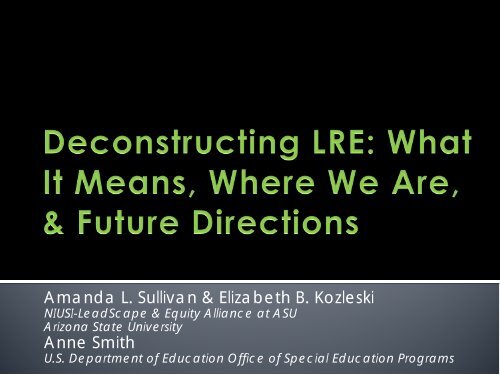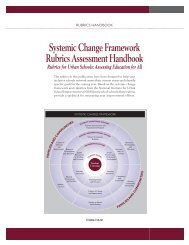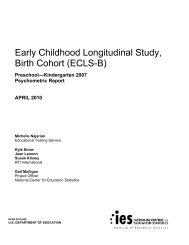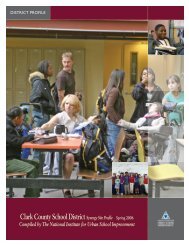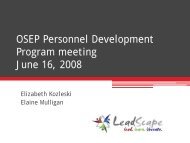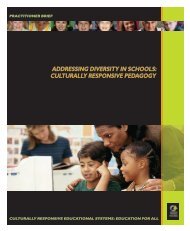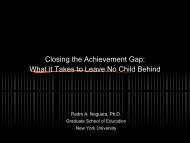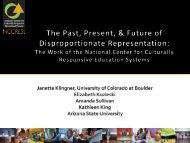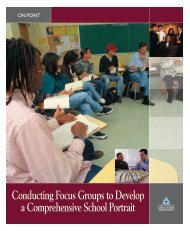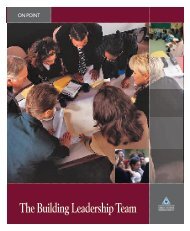Amanda L. Sullivan & Elizabeth B. Kozleski ... - NIUSI Leadscape
Amanda L. Sullivan & Elizabeth B. Kozleski ... - NIUSI Leadscape
Amanda L. Sullivan & Elizabeth B. Kozleski ... - NIUSI Leadscape
Create successful ePaper yourself
Turn your PDF publications into a flip-book with our unique Google optimized e-Paper software.
<strong>Amanda</strong> L. <strong>Sullivan</strong> & <strong>Elizabeth</strong> B. <strong>Kozleski</strong><strong>NIUSI</strong>-LeadScape & Equity Alliance at ASUArizona State UniversityAnne SmithU.S. Department of Education Office of Special Education Programs
www.niusileadscape.org
Agenda‣What is LRE?‣Equity Discussions‣Conceptualizations‣Where We Are‣National Data‣Longitudinal Trends‣Future Directions‣Systemic Change‣Promoting Inclusive Practiceswww.niusileadscape.org
Systemic Change Frameworkwww.niusileadscape.org
Educational EquityBrown v. Board of Education, 1954www.niusileadscape.org
Focus on ensuring that alltraditionally marginalized groupshave access to rich opportunities tolearn‣Necessary supports are providedwithin the general educationclassroom, rather than as a pulloutor self-contained program.‣Special education is considered aset of services, not a place.‣A RIGHT, NOT A PRIVILEGE<strong>Kozleski</strong>, Artiles, Fletcher, & Engelbrecht, 2007www.niusileadscape.org
www.niusileadscape.orgDominantGroupPowerSocial CasteSystems•In all domains ofsociety•Within education andspecial educationMarginalizationMinorityGroups•Special education asa microcosm ofsociety
SpecialEducation &EquityDisproportionalitywww.niusileadscape.org
Discussion Is special education a bankrupt idea? How can we reframe special education sothe balance is on access and opportunity?www.niusileadscape.org
Before IDEA…“…among the alternativeprograms of education andtraining required by the statute tobe available, placement in aregular public school class ispreferable to placement in aspecial public school class andplacement in a special schoolclass is preferable to placementin any other type of program ofeducation and training.”PARC v. State ofPennsylvania, 1971www.niusileadscape.org
IDEALeastRestrictiveEnvironment[Sec. 612 (a)(5)(A)]“To the maximum extent appropriate,children with disabilities, including childrenin public or private institutions or othercare facilities, are [1] educated withchildren who are not disabled, and [2]special classes, separate schooling, orother removal of children with disabilitiesfrom the regular educational environmentoccurs only when the nature or severity ofthe disability of a child is such thateducation in regular classes with the useof supplementary aids and servicescannot be achieved satisfactorily.”www.niusileadscape.org
General Education ClassroomItinerant TeacherResource RoomSpecial ClassSpecial SchoolResidentialSchool/Institutionwww.niusileadscape.orgAdapted from Sands,<strong>Kozleski</strong>, & French, 2000
RTI for Whom?Sailor, W. (2008, Sept.). Inclusion through a different logic model. Invited presentation at the 2008Global Summit on Education, Washington, DC.Designing Schoolwide Systems for Student SuccessAcademic Instruction(with fidelity measures)Behavioral Instruction(with fidelity measures)Reduces Numbers of StudentsTertiary Interventions(for individual students)• Assessment-based• Resource IntensiveSecondary Interventions(for some students: at-risk)• Some individualizing• Small Group Interventions• High Efficiency• Rapid ResponseUniversal Interventions(for all students)• Preventive, Proactive• Differentiated Instruction• Research ValidatedCurriculumMonitoring Student ProgressMonitoring Student ProgressTertiary Interventions(for individual students)• Wraparound Intervention• Complex Multiple Life DomainFBA/BIPsSecondary Interventions(for some students: at-risk)• Simple FBA/BIPs• Group Intervention withIndividual Features• Group InterventionUniversal Interventions(for all students)• Direct Instruction of BehavioralExpectation• Positive AcknowledgementIncreases Levels of SupportScreen All StudentsRtI conceptual system with general and special education integrated at all three levels
What are the concerns and opportunitiescreated by RTI? How does it move us towards a different way ofdoing things? What is the relationship between RTI andinclusive education? If RTI is really successful, does specialeducation become obsolete?www.niusileadscape.org
“The Act’s strong presumption in favorof mainstreaming…would be turnedon its head if parents had to provetheir child was worthy of beingincluded, rather than the school districthaving to justify a decision to excludethe child from the regular classroom…”www.niusileadscape.org
Many Interpretations of LRE… The environment in which othernondisabled students are educated The environment that is leastrestrictive for the student Mainstreaming Integration Inclusive Education• …and many interpretations of “inclusive”www.niusileadscape.org
EXAMPLE 1EXAMPLE 2Peterson School Districtdefines LRE as theenvironment in whichother, typically developingstudents are educated. So,Peterson created a systemin which services tostudents with disabilities aredelivered in generaleducation classrooms withbackup available in othersettings only as needed.www.niusileadscape.orgWilson School District assumesthat students with certaindisabilities are provided LREwhen their access to generaleducation curriculum isprovided in classrooms with lowstudent-to-teacher ratioswhere other students withsimilar needs are educated. So,Wilson has created a system ofservices where students withdisabilities are in resourcerooms, special classrooms, orspecial schools.
www.niusileadscape.orgThings to ConsiderAre theservices agood fit tostudents’needs?What are theimplicationsof the“hardening”of eligibilitycategories?What isour unitofanalysis?What istheintent ofthe law?Are theservicesprovided inthe leastrestrictiveenvironmentpossible?What does“individualizedprogram”mean?Are supportsindividualizedto meet thelearner’sneeds?IDEA isconcernedwithservices,notprograms.How arerace anddisabilityconflated?Are thedistrict’ssystems flexibleenough tomeet students’individualneeds?What is the prevailing thinking in your localexperience?Are people thinking about each ofthese ideas?
Situated Perspectives Conceptualizations of LRE are fluid. In some cases, we have gonebackward in our thinking, resulting in aloss of progress. But, placement practices and trendsremain largely unchanged. We still segregate students who areidentified with the most severedisabilities. Understanding and utility of data areconfounded by changes in reportingcategories.www.niusileadscape.org
4035302520151050GeneralEducationClassResourceRoomSeparateClassSeparateFacilitySource: U.S. Department of Education, 1997www.niusileadscape.org
10090807060504030Separate School< 40%40-79%> 80%20100www.niusileadscape.orgIDEAdata.org 2007 Table 2-2
70.0060.0050.0040.0030.0020.002004200710.000.00IDEAdata.org 2007 Table 2-2www.niusileadscape.org
Percentage of Students Removed fromGeneral Education
Percentage of Students Removed fromGeneral Education >60% of Time by Year706050403020AllLDID1001989 1993 1997 2001 2005IDEAdata.org 2007 Table B4Awww.niusileadscape.org
Percentage of Students Removed fromGeneral Education
Percentage of Students Removed fromGeneral Education >60% of Time by Year –By Race353025201510Native AmericanBlackLatinoWhiteAsian501998 1999 2000 2001 2002 2003 2004 2005www.niusileadscape.orgIDEAdata.org 2007 Table B4A
Relative Risk of Placement ≥80% inGeneral EducationRelative Risk of Placement inSeparate Public Schoolswww.niusileadscape.orgU.S. Department of Education, Office of Special EducationPrograms, Data Analysis System (DANS) – 2005-2006
Relative Risk of Placement≥80% in General EducationRelative Risk of Placement inSeparate Public Schoolswww.niusileadscape.orgU.S. Department of Education, Office of Special EducationPrograms, Data Analysis System (DANS) – 2005-2006
Relative Risk of Placement≥80% in General EducationRelative Risk of Placement inSeparate Public Schoolswww.niusileadscape.orgU.S. Department of Education, Office of Special EducationPrograms, Data Analysis System (DANS) – 2005-2006
Relative Risk of Placement≥80% in General EducationRelative Risk of Placement inSeparate Public Schoolswww.niusileadscape.orgU.S. Department of Education, Office of Special EducationPrograms, Data Analysis System (DANS) – 2005-2006
Discussion• What does this tell us about how systems aredealing with diversity in special education?• What does this say about who is receivinginclusive education and who thinks inclusiveeducation is for them?
IDEA 2004 & State Performance Plans•Annual reports required by OSEP to documentstates’ progress in improving educational outcomesfor students with disabilities.o To evaluate the implementation of IDEAo To describe improvement efforts for the future•Includes indicators in several domains includingdiscipline, disproportionality, transition, graduation,parent involvement, dispute resolution, placement,etc.www.niusileadscape.org
Placement CategoriesPercent of Children with IEPs aged 6 – 21:A. Removed from regular class 60% of dayC. Served in public or private separate schools,residential placements, or homebound or hospitalplacementsNote: difference in reporting compared to IDEAdatawww.niusileadscape.org
Educational Placements of Students withDisabilities Nationally60%54.78%57.77%50%40%30%20%14.92%13.58%20042005200610%3.69%3.74%0%A B Cwww.niusileadscape.org
• To what extent are SPP data madeavailable to the public?• How are SPP data used to inform systemschange efforts?Discussion
States’ Improvement ActivitiesNumber and Type of Reported ImprovementActivitiesImprove data collection and reporting 7Improve systems administration and 28monitoringBuild systems and infrastructures oftechnical assistance and supportProvide technicalassistance/training/professionaldevelopmentClarify/examine/develop policies andproceduresProgram development 10Collaboration/coordination 7Evaluation 5Increase/Adjust FTE 1Other 144719• What do thesepractices look like?• What do theseactivities reallymean?• There is not externalcritique orvalidation for whatis going on.• Is this right?• Is it what it shouldbe?www.niusileadscape.org
Reported Areas of TATechnicalAssistance: Data collection and reporting Special education identificationand placement Classroom instruction Collaboration Behavior supportwww.niusileadscape.org
Topic AreaStatesDifferentiated Instruction 10Response to Intervention 7Positive Behavior Support 7Classroom Accommodations 7Co-teaching 6Reading Interventions 6IEP Planning 6Universal Designs for Learning 5Assistive Technology 4Collaboration 4Inclusion 3Autism 3www.niusileadscape.org
• State-wide emphasis on access• Trend toward “resource rooms” over selfcontainedplacements• Improved data reporting• Implementation of co-teaching models• Influence of the monitoring process• Influence of NCLB• Impact of professional development• Slippage = problems with data reporting• How do states view progress?• Inclusion for whom?• Inclusion for what purpose?www.niusileadscape.org
Are SPP efforts futile?◦ Improvement Activities: Clerical tasks v. real change◦ State goals: Is improvement the goal? SPP data v. IDEAdata.org◦ Why are the data different?◦ What do the different calculations mean for thestudents being served? Why not disaggregate by eligibility category?◦ Or race/ethnicity?www.niusileadscape.org
Discussion What can states do to ensure that there isvalidation of improvement activities? How can the SPP be changed to facilitate realchange for students?www.niusileadscape.org
• Schools are systems, generally rigidbureaucracies.• Systems must adapt to meet theneeds of the students.• Need to examine the relationshipsbetween people, systems, contexts,policies, etc.• Are they aligned or are they disjointedand isolated efforts?• Do they leverage coherent improvement?www.niusileadscape.org
Systemic Issues• Green revolution v.bussing forsegregation• Equity &marginalization• Systems’ stewards• Wraparound services• Unified/collaborativesystemsIndividual Issues• Sustainability• Building patterns ofgenerational care• Education of theprofessionwww.niusileadscape.org
Factors Shaping Educators’ PracticesValues,beliefs,temperamentCulturalWork ofteaching&learningLeadershipResourcesToolsKnowledge& SkillsPracticeswww.niusileadscape.org
Cultures intheClassroomWhat students andteachers bring with themWhat’s alreadythereTheClassroomCultureClassroomCulturesThe work peopledo togetherwww.niusileadscape.org
www.niusileadscape.org
<strong>NIUSI</strong>-LeadScape Assessment Guide forSchoolswww.niusileadscape.org
www.niusileadscape.org
Contact Information<strong>Elizabeth</strong> B. <strong>Kozleski</strong>, Project Director<strong>Elizabeth</strong>.<strong>Kozleski</strong>@asu.edu(480) 965-0391<strong>Amanda</strong> <strong>Sullivan</strong>, Evaluation Coordinator<strong>Amanda</strong>.L.<strong>Sullivan</strong>@asu.eduAnne Smith, Project OfficerAnne.Smith@ed.govVisit our websites for more information:www.niusileadscape.orgwww.nccrest.org


